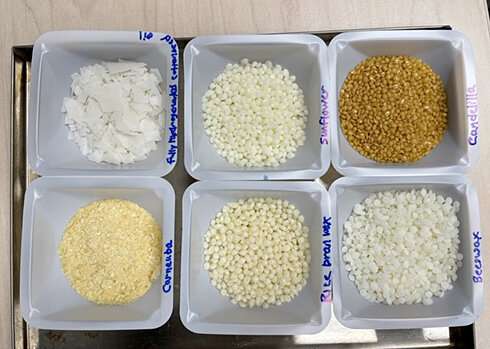Researchers are replacing saturated fat with sunflower, rice bran, candelilla and other natural waxes to create healthier margarines and spreads for consumers. Credit: Functional Foods Research Unit
A dollop of margarine or spread can go a long way to livening up a slice of toast, a piping hot ear of corn or other food. But that enhanced flavor can also come with a side helping of worry over consuming saturated fats, which are used as solidifying agents in some margarines and spreads and give them their butter-like properties.
Jill Moser and Hong-Sik Hwang, research chemists with the Agricultural Research Service (ARS) in Peoria, Illinois, want to create a healthier product by replacing those fats with plant-based and other natural waxes—sunflower, rice bran, candelilla and beeswax, among them. They do this by melting the waxes in hot vegetable oil and letting it cool to room temperature. This results in a semi-solid substance called an oleogel. When mixed with water, salt and other ingredients, the oleogel mimics the role of saturated fat in producing a margarine, spread or shortening that has the desired firmness, mouthfeel, melting point, shelf-life and other properties, including when used in baked goods.
Artificial trans fats (those not naturally present in meat and dairy products but rather created via a chemical process called partial hydrogenation) were once the popular choice for making margarines, spreads and shortening. However, artificial trans fats were phased out of use in 2021 over concerns their consumption can increase the risk of heart disease and stroke. Saturated fats without a trans structure, such as from palm oil and fully hydrogenated vegetable oil, are among the replacements now used to make margarine, spreads and shortening. Consumers, though, are advised to limit their intake of saturated fats from foods or beverages that contain them.
Using wax-based oleogels, "we think 100% of the saturated fats can be replaced, including saturated fat in palm oil and fully hydrogenated vegetable oil," said Hwang, who, together with Moser, is located at the ARS center's Functional Foods Research Unit in Peoria.
The wax-based oleogels are made of a network of plate-like crystals that immobilize molecules of oil in a gel state that mimics the function of solid saturated fat in margarines and spreads—minus the associated human-health concerns.
To date, the researchers have created oleogel formulations from four different natural waxes and 12 different kinds of vegetable oils, including soy and, most recently, hemp seed oil, which is rich in beneficial polyunsaturated fats and antioxidants, including Vitamin E. Their latest research is published in the Journal of the American Oil Chemists' Society.
Of the waxes they've worked with, sunflower and rice bran seem to work best in creating margarines and spreads that compare to those made from fully hydrogenated (saturated) vegetable oil. Very little wax is needed, too. In one experiment, between 2 and 6% of sunflower wax was needed to create an oleogel that was nearly as firm as margarine containing 18 to 30% of saturated soy oil.
Oleogel ingredients can come from a variety of sources, but those derived from plant waxes are especially of interest because they are "generally recognized as safe" by the U.S. Food and Drug Administration and are abundant and inexpensive. Sunflower waxes, for example, are waste products generated from refinery procedures used to remove impurities from crude oil in the flowering crop's seed. Similarly, rice bran waxes are waste byproducts of husk-oil refining methods.
The researchers continue to refine the oleogel formulations, for example, by blending different waxes with oils to achieve the very best combination of properties expected in a margarine or spread. Their efforts and collaboration with industry are part of a larger research effort at the ARS center to usher in new, value-added uses for both established crops such as corn and soybeans and newer ones such as penny cress and hemp that will benefit producers and consumers alike.
More information: Hong‐Sik Hwang et al, Feasibility of hemp seed oil oleogels structured with natural wax as solid fat replacement in margarine, Journal of the American Oil Chemists' Society (2022). DOI: 10.1002/aocs.12619
Jill K. Winkler‐Moser et al, Physical Properties of Beeswax, Sunflower Wax, and Candelilla Wax Mixtures and Oleogels, Journal of the American Oil Chemists' Society (2019). DOI: 10.1002/aocs.12280
Provided by United States Department of Agriculture






















